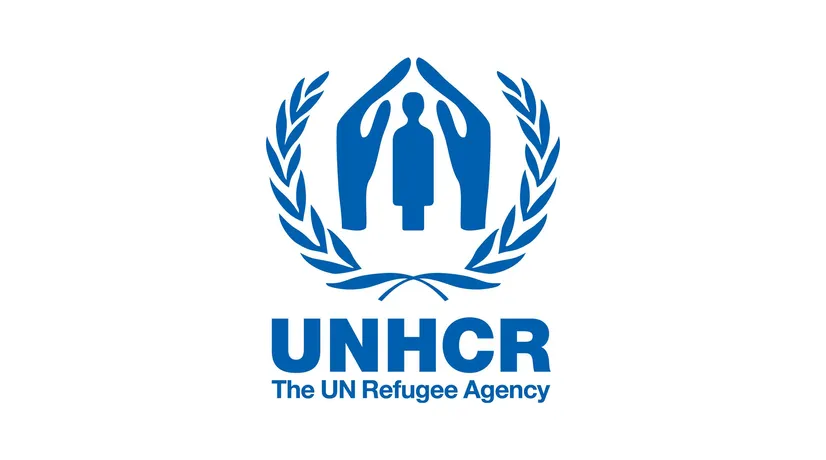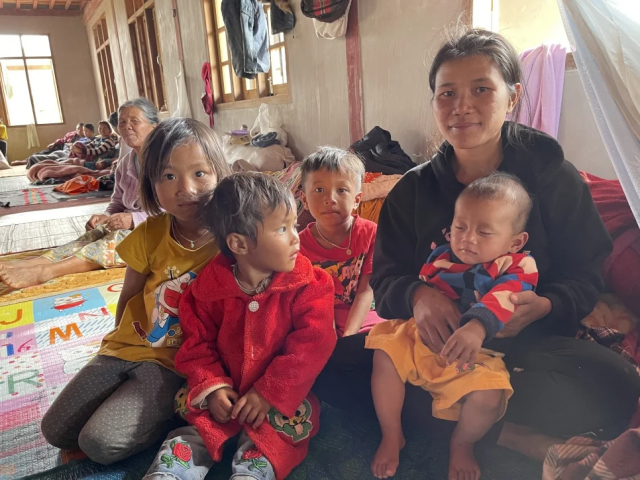Displaced families in crisis-hit Myanmar struggle for survival
11 February 2022

Some 440,000 people forced from their homes inside the country since February 2021 have sought refuge wherever they can, often fleeing again and again.
By Reuben Lim Wende and Yin Yin Myint in Myanmar

Anna Ruth* with her children outside the monastery in Shan State where she sought shelter after being displaced multiple times in Kayah State. © UNHCR/Yin Yin Myint
Anna Ruth* vividly remembers the day her husband was killed as the family tried to escape gunfire for the second time in less than a year.
When fighting between the Myanmar Armed Forces and other armed groups reached the village they had sought refuge in near Loikaw, the capital of Myanmar’s south-eastern Kayah State, she and her family fled with other villagers to the nearby forest to hide. But her husband and some of their neighbours wanted to go back to gather food and other essentials.
“I told him not to go because it was too dangerous, but he didn’t listen,” she recalls. “In the evening, the group returned but my husband did not. I later found out that he was shot while collecting some belongings from my mother-in-law’s house where we had been sheltering.”
In Kayah State, a humanitarian crisis has been building since renewed armed conflict broke out in May 2021. With six of the state’s seven townships now affected by intense fighting, tens of thousands of people have been forced to flee their homes. Some have sought safety at places of worship and community centres, while others are hiding in the jungle.
Across Myanmar, similar patterns have been playing out of clashes between the Myanmar Armed Forces, ethnic and other local armed groups, followed by waves of fresh displacement. Since the military takeover on 1 February 2021, some 440,000 people have been forced to flee airstrikes, shelling, and burning of villages, more than half of them in the south-east of the country, with Kayah and Kayin States the worst affected.
Anna Ruth and her family, like many others in Kayah State, have been displaced several times. “We have been running since June 2021,” she explains. “First from our village in Demoso Township to my mother-in-law’s in Loikaw Township, and from there to the forest where we stayed for months.”
Left widowed with four young children, she eventually sought safety in another village in Loikaw Township, only to be displaced again a few weeks later when fighting intensified across Kayah State last month. Desperate for safety and unsure where to go next, Anna Ruth followed other displaced families and crossed into neighbouring Shan State.
“I’ve lost everything except my children.”
“I never imagined that this would happen to me. Before, my family was living happily in our village. Now, I’ve lost everything except my children,” she said.
They are now sheltering at a monastery where, in scenes repeated across Myanmar, the local community and local charities are showing solidarity and leading the humanitarian response. Despite their best efforts, resources are increasingly stretched as more displaced people arrive.
UNHCR, the UN Refugee Agency, has been working with local partners and communities to relieve some of this pressure and supplement grassroots aid efforts to assist some 30,000 people who have arrived to Shan State from Kayah State since the beginning of the year. The agency has set up a temporary base in the Shan State capital, Taunggyi, to coordinate distribution of emergency aid in the area and address shortages of basic household materials and clothing.
Over the past few weeks, some 10,000 internally displaced people from Kayah, spread across several townships in Shan State, have received blankets, kitchen sets, mosquito nets, jerry cans, buckets, sleeping mats, tarpaulins, and winterization kits. Local well-wishers have also contributed items such as toothbrushes, soap, and shampoo.
Having arrived with few possessions, Anna Ruth is grateful for the help. “At first, we were unsure about taking shelter at the Buddhist monastery as we are Christians,” she explained. “But the monks warmly welcomed all of us. Now, we live together with other displaced people in harmony. The blankets, buckets, mats and clothing provided are very helpful for us as I was only able to bring some of my children’s clothing with me.”
With the ongoing conflict in Kayah State showing no sign of abating, further displacement towards Shan State is expected in the weeks, and even months to come.
While relieved to have found a place of refuge, Anna Ruth yearns to return to her native Kayah State. “My children keep asking when they can go back home. We hope we can return soon.”
*Names changed for protection reasons.
Announcements
21 May 2025
Open letter: Malaysia must lead ASEAN with principle, not hypocrisy, to address the Myanmar crisis

Progressive Voice is a participatory rights-based policy research and advocacy organization rooted in civil society, that maintains strong networks and relationships with grassroots organizations and community-based organizations throughout Myanmar. It acts as a bridge to the international community and international policymakers by amplifying voices from the ground, and advocating for a rights-based policy narrative.